Physical Address
304 North Cardinal St.
Dorchester Center, MA 02124
Substantial advances in the diagnosis and classification of lymphoid, myeloid, and histiocytic neoplasms have been made in recent years. Dramatic improvements in genetic techniques have led to recognition of the underlying genetic abnormalities in many of these neoplasms, opening the door to identifying targeted therapy and improved prognosis.
Primary lymphoma of bone (PLB) is a malignant neoplasm of lymphoid cells producing one or more lesions in bone with or without regional lymph node involvement, without the involvement of more distant lymph nodes or of other extranodal sites. PLB accounts for <1% of all lymphomas. Approximately 3% of primary neoplasms of bone and 5% of extranodal non-Hodgkin lymphomas are PLB.
Nearly all (>90%) PLB are diffuse large B-cell lymphoma (DLBCL). There is a male preponderance, with a male:female ratio of approximately 1.5:1 to 2:1. PLB affects patients over a broad age range; however, most patients are adults, with a median age in the fifth to sixth decades. The other lymphomas that rarely arise primarily in bone include low-grade B-cell lymphomas, anaplastic large cell lymphoma, other T-cell lymphomas, B-lymphoblastic lymphoma, and classic Hodgkin lymphoma. Among children, DLBCL is the most common type, but accounts for only approximately half of pediatric PLB. B-lymphoblastic lymphoma is the next most common, making up nearly 40% of cases. The remainder are anaplastic large cell lymphoma, ALK+, and Burkitt lymphoma.
Almost all patients present with pain in the involved bone, sometimes with swelling or palpable mass, and usually without systemic symptoms. PLB with pathologic fracture can occur ( Fig. 19.1 ) and is most common in the weight-bearing long bones of the lower extremities. Vertebral involvement can lead to spinal cord or nerve root compression in the setting of a fracture or epidural extension.
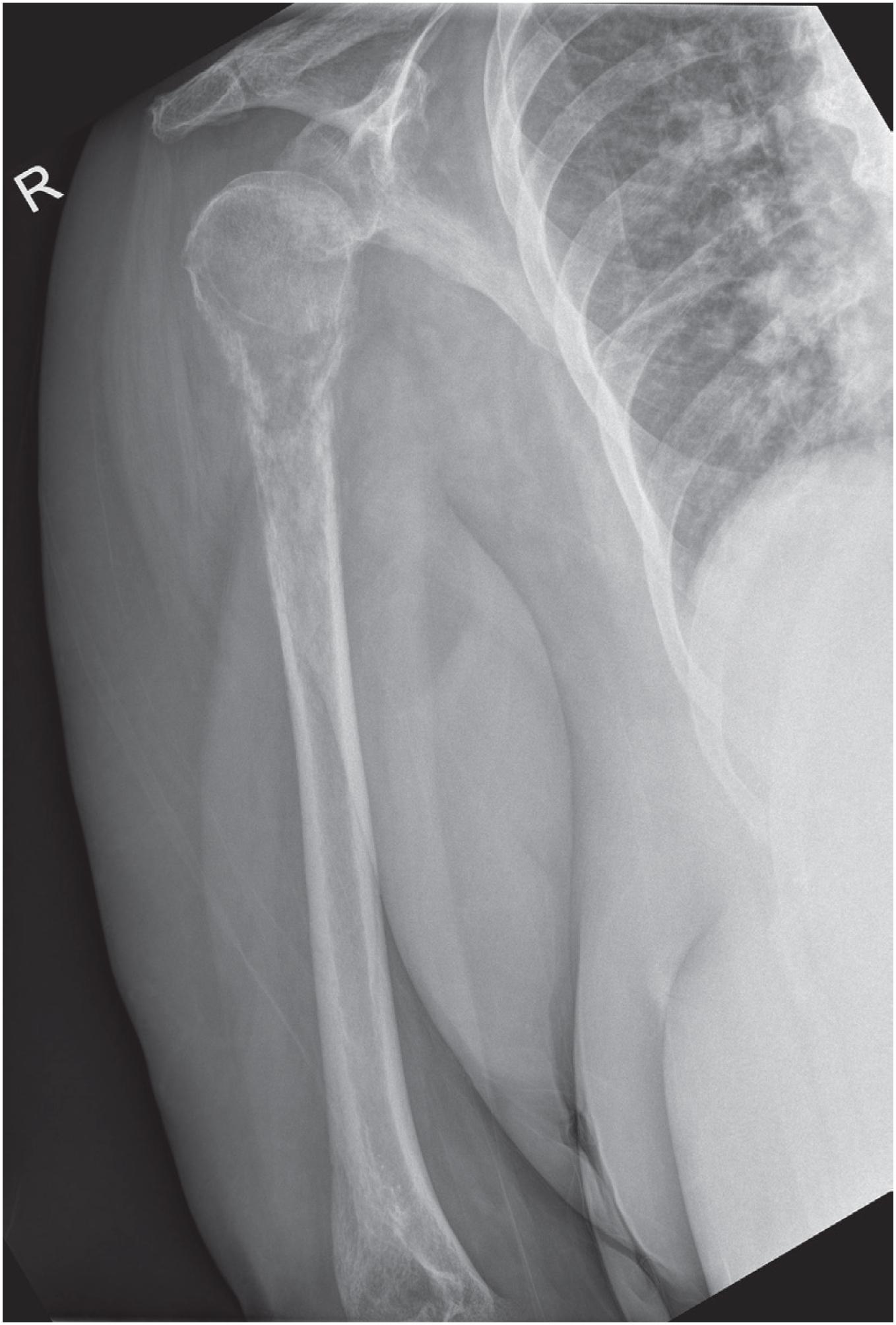
PLB affects both the axial skeleton and the appendicular skeleton. The bones of the lower half of the body are more often involved than are those of the upper half. The femur is most often involved, followed by the spine, pelvis, tibia, humerus, skull, jaw, and ribs. The scapula, other long bones (ulna, radius, fibula), and clavicle are less often affected. Involvement of the hands and feet is rare. Localized, monostotic, unifocal involvement is more common than is multifocal or polyostotic disease. A few cases are multifocal within a single bone. Polyostotic disease is more common among children.
PLB is typically a poorly demarcated, permeative, lytic lesion, occasionally with a mixed lytic and sclerotic appearance. Rarely, the lesion is entirely sclerotic. Extension into the soft tissue is common. There may be an associated periosteal reaction. Pathologic fracture is seen in a minority of cases ( Fig. 19.1 ).
Lymphoma diffusely involves the marrow space, usually has a tan color, often with hemorrhage and necrosis.
DLBCL, by far the most common type of PLB, is composed of large atypical cells with irregular nuclei, multilobated nuclei, centroblasts with round to oval nuclei, vesicular chromatin, and peripheral nucleoli, immunoblasts with prominent central nucleoli, elongate spindle cells, or bizarre cells. Crush artifact is common. Many admixed small lymphocytes and histiocytes and areas of fibrosis may be present. Reactive woven bone is often present at the periphery of the lesion. Fracture callus consistent with pathologic fracture may be seen ( Fig. 19.2 ).
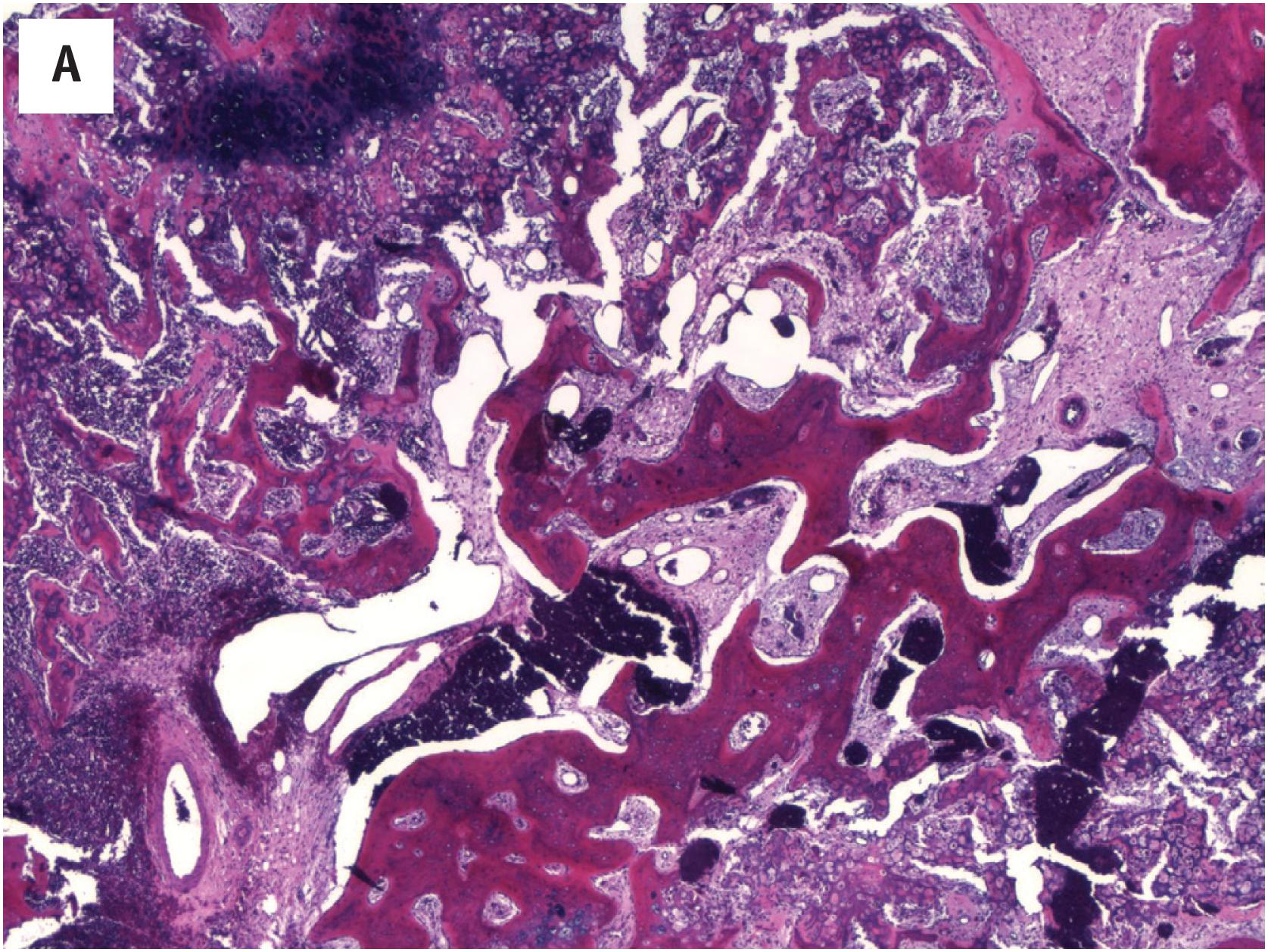
Primary DLBCL of bone expresses pan-B-cell markers (CD20+, Pax5+, CD79a+) and monotypic immunoglobulin (IgG > IgM). DLBCL with a germinal center B-cell (GCB) (CD10+ or CD10-, BCL6+, MUM1-) is more common than is a non-germinal center B-cell (non-GCB) immunophenotype (CD10-, BCL6- or CD10-, BCL6+, MUM1+), using the Hans classifier.
Primary DLBCL of bone exhibits clonal rearrangement of the immunoglobulin heavy chain gene (IGH). Fluorescence in situ hybridization (FISH) for IGH and BCL2 translocation [t(14;18)] is positive in approximately 25% of cases. Translocations involving BCL6 are uncommon, but there may be mutations within the BCL6 gene that contribute to the development of lymphoma. Using FISH, a minority of cases harbor rearrangements of MYC (9% to 29% in different series). Rare cases of “double-hit” high-grade lymphomas with concurrent BCL2 and MYC rearrangement are described.
The gene expression profile of primary DLBCL of bone most closely resembles non-osseous DLBCL of germinal center centrocyte origin (DLBCL-GC-CC), rather than DLBCL of germinal center centroblast origin (DLBCL-GC-CB). The abnormalities detected by array CGH include the loss of 14q32 (likely reflecting clonal IGH rearrangement), trisomy 7, gain of 1q, and amplification of 2p16.1 (site of REL oncogene, activating NFkB). Also described is a distinctive microRNA profile.
Primary DLBCL of bone is typically unassociated with Epstein-Barr virus (EBV). An exception is plasmablastic lymphoma, a distinctive type of DLBCL that is often associated with immunodeficiency and usually contains EBV. The rare DLBCLs arising in association with chronic osteomyelitis that have been tested also contain Epstein-Barr virus; the WHO Classification terms this DLBCL associated with chronic inflammation.
Optimal radiation therapy to the primary site effectively prevents local relapse but does not prevent distant relapse. A combination of anthracycline-based chemotherapy and radiation is usually recommended to increase the chance of cure for adult patients. Chemotherapy alone is preferred for children, as the outcome is good and decreases the risk of secondary sarcomas compared to radiated bone.
Primary DLBCL of bone has a better prognosis than do most other malignancies arising in bone and most extra-osseous DLBCL. Up to 90% of optimally treated patients achieve complete remission. In some series, the 5-year survival is over 80%, and as high as 90% for patients under age 60. Gene expression profiling exhibiting the DLBCL-GC-CC origin correlates with a favorable prognosis: in general, DLBCL-GC-CC has a better prognosis than does DLBCL-GC-CB.
Relapses occur in a minority of DLBCL patients; they may involve the primary site, other bones, regional lymph nodes, other lymph nodes and, infrequently, other sites, including the lungs, bone marrow, and central nervous system (CNS). A variety of clinical and pathological features affect the prognosis of DLBCL of bone. An unfavorable outcome is associated with a higher stage, polyostotic disease, soft tissue extension, vertebral or pelvic primary, older age, pathologic fracture at presentation, elevated serum LDH, and neoplastic cells that are centroblasts, immunoblasts, or pleomorphic. A superior outcome is associated with age <60 years, lymphoma arising in a long bone, lymphoma composed of large irregular cells or multilobated cells, GCB phenotype, and complete response with initial therapy.
Diffuse large B-cell lymphoma
Incidence and location
By far, the most common primary lymphoma of bone (>90% of cases)
Axial and appendicular skeleton affected
Bones in lower half of body more often affected
Most commonly involved bone is the femur
Males more affected than females
No known racial predisposition
Most are adults, with median age in 5 th –6 th decades
Pain in the involved bone, sometimes with palpable mass or swelling
Fractures may occur especially in weight-bearing bones
Poorly demarcated, permeative, lytic lesion, often with soft tissue extension, +/- pathologic fracture
Adults: usual treatment is radiation with combination chemotherapy
Children: usual treatment is chemotherapy alone
Microscopic features
Diffuse infiltrate of irregular or multilobated cells, centroblasts, or immunoblasts
CD45+, CD20+, CD10+/–, BCL6+/–, BCL2+/–, MUM1/IRF4+/–, sIg+ (often IgG)
Clonal IGH; other changes variable
Uncommon; mainly affects children
Diffuse infiltrate of medium-sized, oval or irregular cells with fine chromatin and scant cytoplasm
CD45+/–, CD19+, Pax5+, CD20–, CD10+, TdT+, CD34+/–, sIg–
Rare type of primary lymphoma of bone
Diffuse infiltrate of uniform, medium-sized cells with round nuclei, clumped chromatin, several nucleoli/cells, and moderate amount of cytoplasm with numerous mitoses and tingible body macrophages
CD45+, CD20+, CD10+, BCL6+, BCL2–, Ki67 100%, sIgM+
Rare type of primary lymphoma of bone
Affects children and young adults
Male preponderance
Diffuse infiltrate of large cells with oval or indented nuclei, relatively abundant cytoplasm, hallmark cells
CD30+, ALK+, MUM1+, T antigen +/–, EMA+/–
Less favorable than ALK+ ALCL in most other sites
Rare type of primary lymphoma of bone
Similar to ALCL, ALK+, but without expression of ALK
Poor
Rare type of primary lymphoma of bone
Male Preponderance
Unifocal or multifocal lesions in bone that tend to involve spine and pelvis
Lymph node involvement is usually also found
Large atypical Reed-Sternberg cells and variants in a mixed background of lymphocytes, histiocytes, eosinophils and/or neutrophils, often associated with fibrosis
Neoplastic cells : CD30+, CD15+, Pax5 weak +, CD20-, MUM1+
Small lymphocytes : CD3+ T cells usually more numerous than CD20+ B cells
Chronic Osteomyelitis
Lymphocytes, plasma cells +/– neutrophils with bony necrosis often with reactive woven bone
Mixture of B and T cells; polytypic plasma cells
Pure population of mature or immature plasma cells growing in sheets
CD45–, CD20–, Pax5–, CD138+, CD56+/–, cyclinD1–/+, sIg–, cIg+
Diffuse infiltrate of primitive cells with round or irregular or folded nuclei, usually slightly smaller, and with finer chromatin than large lymphoid cells, with scant to moderate quantity of cytoplasm
CD45+/–, lysozyme+, myeloperoxidase +/–, CD68+/–, CD34+/–, CD117+/–
Diffuse infiltrate of small, uniform cells with pale, glycogen-rich cytoplasm and distinct cell borders
Vimentin +, CD99+, FLI–1+, NSE–/+, synaptophysin–/+, chromogranin–/+, cytokeratin–/+
ALK+ anaplastic large cell lymphoma (ALCL) and ALK– ALCL primary in bone are reported. Although ALCL is rare, it is likely the most common type of primary osseous T-cell lymphoma. Both ALK+ and ALK– ALCL appear to be characterized by a higher male:female ratio than that among patients with DLBCL. There is also a stronger predilection for the axial skeleton and more frequent multifocal involvement than with DLBCL primary in bone. ALK+ ALCL mainly affects children and young adults. Histologic and immunophenotypic features are similar to those in other sites. Patients have usually been treated with combination chemotherapy with or without radiation. The prognosis may not be as favorable as that of ALK+ ALCL in other sites. ALK– ALCL affects adults over a wide age range. The prognosis is poor; most patients die of lymphoma.
B-lymphoblastic lymphoma primary in bone mainly affects children, although occasionally young and middle-aged adults are affected. B-lymphoblastic lymphoma usually involves long bones. On radiographic evaluation, lesions are usually single and lytic, but may be multiple, and may be mixed lytic and sclerotic or rarely primarily sclerotic. Evaluation of the peripheral blood and bone marrow is required to exclude concurrent acute lymphoblastic leukemia. Neoplastic cells are typically CD19+, CD20–, CD10+, TdT+; CD45 may be positive, negative, or very weak ( Fig. 19.3 ).
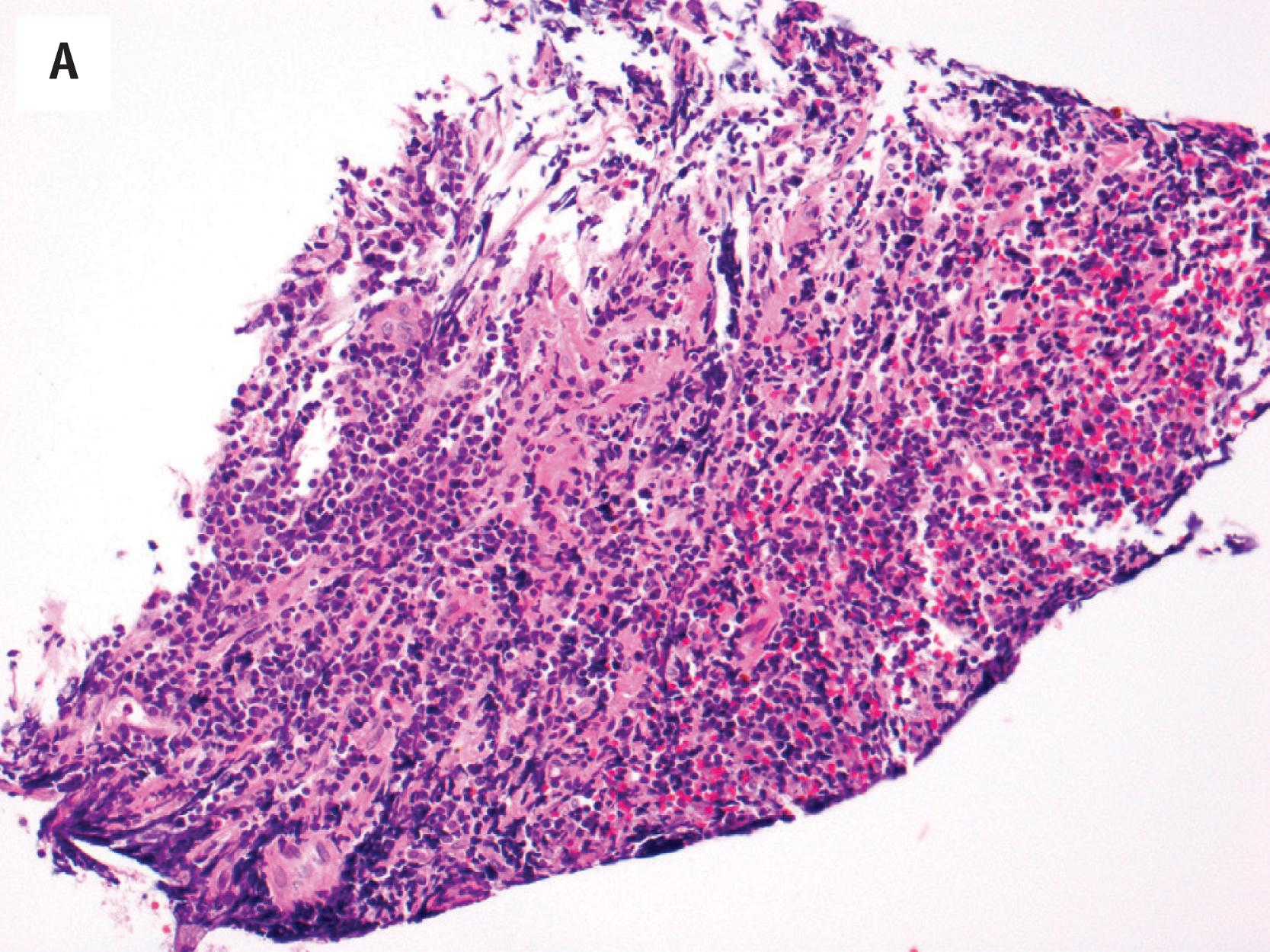
Other types of B- and T-cell lymphoma are rare. They include Burkitt lymphoma, low-grade B-cell lymphomas, peripheral T-cell lymphomas, NOS, T-lymphoblastic lymphoma, adult T-cell lymphoma (HTLV-1+) and NK/T-cell lymphoma. Peripheral T-cell lymphoma of bone appears more prevalent in series from East Asia. The prognosis depends on the type of lymphoma and clinical factors.
Rare cases of classic Hodgkin lymphoma presenting with bone involvement are reported. Males are affected more than are females. The most common symptom is pain, and staging discloses lymph node involvement in almost all cases. Osseous lesions can be unifocal or multifocal. The most common sites are the spine, pelvis, and sternum. Lesions can be osteolytic or osteosclerotic. The pathologic findings are similar to those in other sites.
The clinical and radiographic features of primary lymphoma of bone (PLB) are not specific. The differential diagnosis includes osteomyelitis, plasmacytoma, myeloid sarcoma, Langerhans cell histiocytosis, Ewing sarcoma, and other small round cell neoplasms. Multiple lesions can suggest plasma cell myeloma and metastases. Rendering the correct diagnosis may be difficult because of associated crush artifact, excessive decalcification, small biopsy size, sampling artifact, and admixture of many reactive cells. PLB can be misinterpreted as a reactive process such as chronic osteomyelitis or as a simple fracture if reactive cells and/or fracture callus predominates or if neoplastic cells are sparse or poorly preserved.
Neoplastic cells of some PLB are elongate and resemble spindle cells, or grow in nests or cords, so that sarcoma and metastatic carcinoma enter the differential diagnosis. PLB can be associated with reactive woven bone formation and mimic osteosarcoma. Plasmacytoma composed of immature plasma cells can mimic DLBCL arising in bone, but plasmacytomas are diffusely CD138+, typically lack B-cell associated antigens CD20 and Pax5, and often express strong monotypic cytoplasmic immunoglobulin light chain on paraffin sections, while DLBCL is typically B-antigen positive, negative for CD138, and negative or occasionally weakly positive for light chains. Individuals with plasmacytomas may have diffuse bone marrow involvement by plasma cell myeloma and a serum paraprotein, in contrast to most patients with DLBCL. Large lymphoid cells typically have slightly larger nuclei, with either more vesicular or more coarsely clumped chromatin, and less delicate nuclear membranes than those of myeloid sarcoma. Differentiation into recognizable maturing myeloid elements, when present, helps to identify a neoplasm as myeloid sarcoma. Myeloid sarcomas with a component of immature monocytes with irregular nuclei can resemble DLBCL with large cleaved or multilobated cells. Lymphoma may also raise the consideration of a small round cell tumor, but Ewing sarcoma has cytoplasmic glycogen, a more cohesive growth pattern, and less pleomorphic nuclei. Neuroblastoma is characterized by pear- or carrot-shaped tumor cells that may be loosely cohesive and with denser chromatin than lymphoma; they may form rosettes.
Differential diagnosis of lymphoblastic lymphoma includes DLBCL, myeloid sarcoma, and Ewing sarcoma. Cases with CD20 expression may be mistaken for DLBCL. Lymphoblastic lymphoma negative for CD45 may be mistaken for Ewing sarcoma or other small round cell tumors. The primitive nuclei may suggest myeloid sarcoma. The characteristic hallmark cells of ALK+ ALCL have relatively abundant eosinophilic cytoplasm and can resemble immature myeloid cells, leading to a misdiagnosis of myeloid sarcoma. Hodgkin lymphoma presenting with involvement of bone can mimic acute or chronic osteomyelitis, depending on the composition of the reactive population, especially if the large neoplastic cells are sparse.
The differential diagnosis of PLB also includes secondary involvement of bone by lymphoma, which is more common than is PLB and is more likely to involve the axial than the appendicular skeleton. A wide variety of types of lymphoma can affect the bones secondarily.
A plasmacytoma is a localized tumor composed of clonal plasma cells. Plasmacytomas can be intraosseous [solitary plasmacytoma of bone (SPB)] or extra-osseous (extra-osseous or extramedullary plasmacytoma). To fulfill the criteria for SPB, there must be no radiographic evidence of other bony lesions, and no evidence of plasma cell myeloma. Plasma cell myeloma is a plasma cell neoplasm with marrow involvement (at least 10% of cells are clonal plasma cells); overt plasma cell myeloma additionally displays evidence of end-organ damage and/or at least 60% marrow clonal plasma cells.
SPB accounts for <5% of all plasma cell neoplasms. Most cases of SPB evolve into plasma cell myeloma (PCM). PCM is much more common than SPB, with an estimated 22,350 new cases, and 10,710 deaths per year in the United States. PCM affects men more than women and Blacks more than Whites; nearly all patients are >50 years of age. Patients with a first-degree relative with PCM have an increased risk of developing PCM themselves. Blacks are also at higher risk than are Whites for SPB. In practice, since a biopsy revealing plasmacytoma may be the first evidence of plasma cell neoplasm in many patients, and the extent of disease is unknown, a diagnosis of plasmacytoma can be made, with a note that clinical, laboratory, and radiographic correlation is required to investigate the possibility of PCM.
SPB affects men more often than it does women, with a male:female ratio that varies among series, but is approximately 2:1 overall. The patients are mostly middle-aged and older adults with a median age of 55 to 60 years. Young adults are occasionally affected. The patients typically present with localized pain, sometimes accompanied by fracture. They commonly have a serum or urine M component, most often IgG followed by IgA, and infrequently light chain only. The axial skeleton is affected more often than is the appendicular skeleton; the bones most often affected are the vertebrae, pelvis, ribs, skull, and long bones. Vertebral SPB with fracture can be associated with spinal cord compression. The complex interaction between the neoplastic cells and the microenvironment leads to osteoblastic inhibition and osteoclastic activation resulting in bone loss.
SPB takes the form of a lytic bone lesion; osseous lesions may be multiple in cases of plasma cell myeloma. In evaluating the patient for additional bony abnormalities, MRI and PET/CT are more sensitive than are plain radiographs alone ( Fig. 19.4 ).

Plasmacytomas take the form of soft, gelatinous, hemorrhagic lesions.
Neoplastic plasma cells in SPB grow in sheets, displacing the normal elements and disrupting the bony trabeculae; evidence of fracture is seen in some cases. The morphology of neoplastic cells can vary among cases. Some are composed of normal-appearing plasma cells with clock-faced chromatin and eccentrically placed cytoplasm; some have small lymphocyte-like plasma cells; many others are composed of atypical, enlarged plasma cells with occasional distinct nucleoli and abundant cytoplasm; and a few have plasmablast morphology with large nuclei, vesicular chromatin and prominent centrally placed nucleoli. Rare cases have anaplastic morphology ( Fig. 19.5 ).
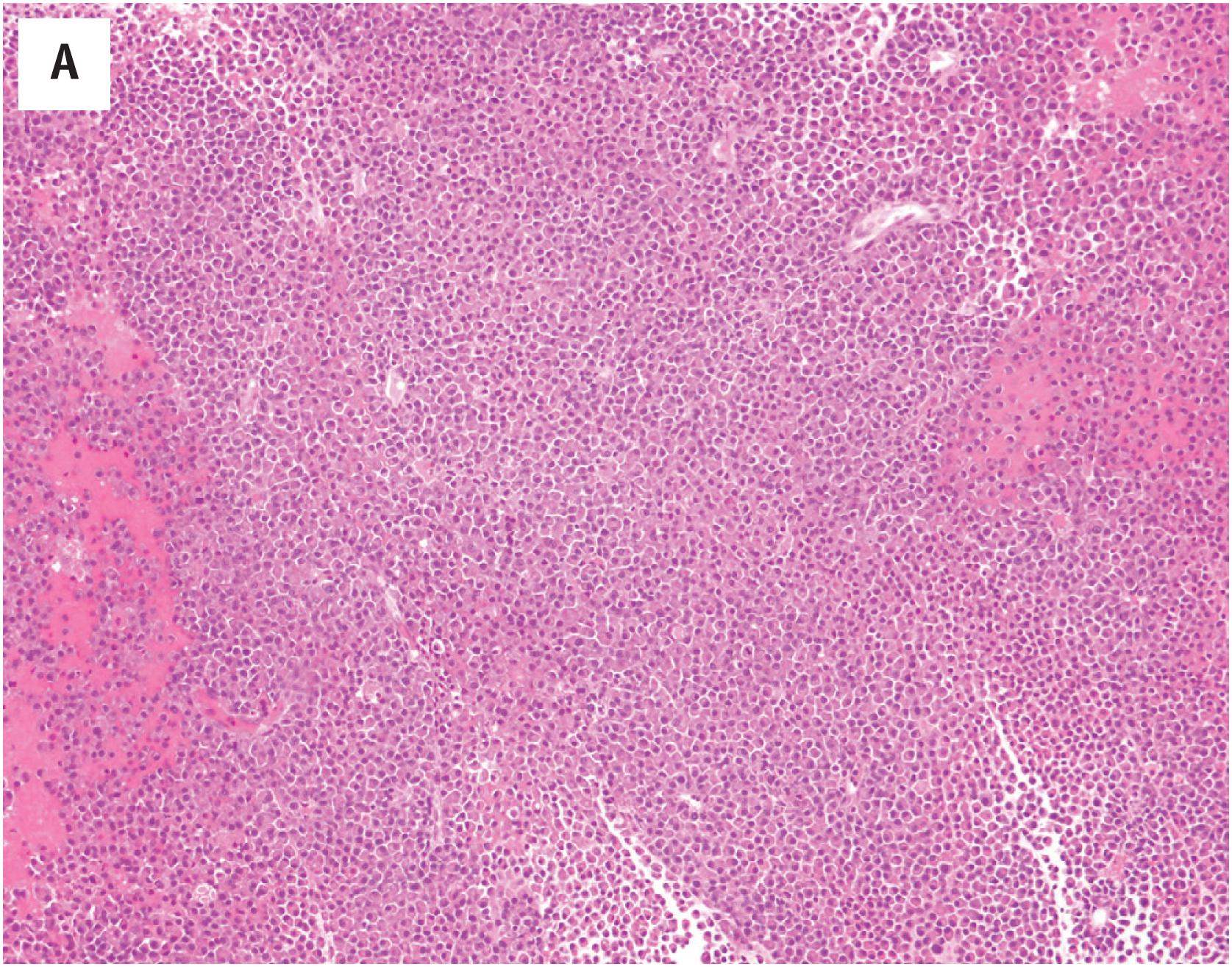
Immunophenotyping can be performed by flow cytometry or immunohistochemistry. Neoplastic plasma cells are typically CD138+, CD38+, CD56+, CD45– or dim, CD19– and monotypic κ+ or λ+. Cases with translocation involving CCND1 (see below) express cyclin D1. A minority of cases are positive for CD20, CD117, or CD10.
Genetic and cytogenetic abnormalities are heterogeneous. Immunoglobulin heavy and light chain genes are clonally rearranged and carry a heavy load of mutations in the variable region of the immunoglobulin heavy chain gene, without ongoing mutations. Complex, abnormal karyotypes are common. FISH is much more sensitive for detecting cytogenetic abnormalities than is routine karyotyping. PCM can be divided into hyperdiploid and non-hyperdiploid cases. Approximately 50% are non-hyperdiploid; they typically have a translocation involving the immunoglobulin heavy chain gene ( IGH ) and another partner. The most common translocation partner is CCND1 , followed by MAF and FGFR3/NSD2 ( FGFR3/MMSET ). IGH translocations with CCND3 , CCND2 , MAFA , and MAFB are rare. Nearly half of cases have a hyperdiploid karyotype, with 48–75 chromosomes. These cases typically have gains of three or more of the odd-numbered chromosomes 3, 5, 7, 9, 11, 15, 19, and 21. IGH translocation is rare among hyperdiploid cases.
Localized proliferation of neoplastic plasma cells (plasmacytoma) or neoplastic proliferation of plasma cells with marrow involvement (plasma cell myeloma)
Plasma Cell Myeloma
More than 22,000 new cases of plasma cell myeloma/year in United States
Solitary plasmacytoma of bone represents <5% of all plasma cell neoplasms
Plasmacytoma (single in solitary plasmacytoma of bone; may be multiple in cases of plasma cell myeloma) more often affect the axial skeleton
Bones most often affected are vertebrae, pelvis, ribs, skull, and long bones
Males more affected than females
Blacks more affected than Whites
Most patients are middle-aged and older adults, nearly all >50 years of age
Plasmacytomas cause localized pain, sometimes with fracture
Lytic bone lesions; MRI and PET/CT are more sensitive than are plain films alone
Radiation provides local control for solitary plasmacytoma of bone
Plasma cell myeloma has a variety of treatment options: chemotherapy, immunomodulaters, proteasome inhibitors, bisphosphonates, and/or high-dose chemotherapy with stem cell transplantation
Most patients with solitary plasmacytoma of bone progress to plasma cell myeloma in 3 years
5-year OS: 70–80%
10-year OS: 40–60%
8–10 years for standard risk cytogenetics; 4–5 years for intermediate risk cytogenetics; 3 years for high-risk cytogenetic changes
Gross Features
Plasmacytomas take the form of soft, gelatinous, hemorrhagic lesions
Pure population of mature or immature plasma cells growing in sheets
CD45–, CD20–, Pax5–, CD138+, CD56+/–, cyclinD1–/+, sIg–, cIg+
Clonally rearranged immunoglobulin genes
Hyperdiploid and non-hyperdiploid
Hyperdiploid group:
48-75 chromosomes
Gains of three or more of the odd-numbered chromosomes 3, 5, 7, 9, 11, 15, 19 and 21
Non-hyperdiploid group:
Translocations of IGH and one of the following partners:
cyclin D genes, MAF and FGFR3 .
t(11;14) CCND1/IGH
t(6;14) CCND3/IGH
Hyperdiploid
All others
t(4;14)
Del 13
Hypodiploid
Del 17p
t(14;16) IGH/MAF
t(14;20) IGH/MAFB
* Adapted from the WHO Classification
Plasma cell myeloma, overt or symptomatic
At least 10% clonal bone marrow plasma cells or biopsy-proven plasmacytoma and
≥1 of the following due to PCM:
Hypercalcemia
Renal insufficiency
Anemia
Osteolytic bone lesions, 1 or more
And/or
≥1 of the following:
Clonal bone marrow plasma cells ≥60%
An involved to uninvolved serum light chain ratio ≥100
>1 focal lesion on MRI
Plasma cell myeloma, smoldering or asymptomatic
Serum M component (IgG or IgA) ≥30g/dL, urinary M component ≥500mg/24 h and/or 10-60% clonal bone marrow plasma cells
No hypercalcemia, renal insufficiency, anemia or bone lesions due to PCM
No amyloidosis
Plasma cell myeloma, non-secretory
As for plasma cell myeloma above, but with no serum or urine M component
Plasma cell leukemia
Plasma cell myeloma with clonal plasma cells in peripheral blood that are >20% of leukocytes or >2.0 x 10 9 /L
Solitary plasmacytoma of bone (SPB)
Single localized tumor of clonal plasma cells in bone
No clonal plasma cells on random bone marrow biopsy
No hypercalcemia, renal insufficiency, anemia, or other bone lesions due to plasma cell myeloma
Extra-osseous (extramedullary) plasmacytoma
As for SPB, but in an extra-osseous site
Solitary plasmacytoma with minimal bone marrow involvement (“plasmacytoma plus”)
As for SPB, but with <10% clonal plasma cells in random bone marrow biopsy
Secondary genetic events are heterogeneous. They include translocations involving MYC; mutually exclusive activating mutations of KRAS , NRAS , and BRAF ; mutations that lead to NFκB activation; and TP53 mutation and/or deletion.
Plasma cell neoplasms with lymphocyte-like morphology can mimic lymphoplasmacytic lymphoma. Cases with anaplastic morphology can mimic a non-hematologic neoplasm. Chronic osteomyelitis may contain many plasma cells, but they are typically small and mature, and express polytypic immunoglobulin. See also the differential diagnosis of lymphoma of bone, above.
Radiation provides effective local control for the vast majority of SPB. The local recurrence rate is high without radiation. Radiation does not prevent progression to plasma cell myeloma, however. The treatment of plasma cell myeloma has evolved substantially over the years. The treatment options include chemotherapy, immunomodulatory therapy (e.g., thalidomide, lenalidomide), proteasome inhibitors (e.g., bortezomib), bisphosphonates to decrease bone loss, and high-dose chemotherapy with stem cell transplantation.
Approximately two-thirds of SPB patients progress to plasma cell myeloma within 3 years; this is significantly more likely among patients with SPB with minimal bone marrow involvement (“plasmacytoma plus”) than in those with no clonal plasma cells on bone marrow biopsy. SPB >5 cm has been associated with recurrence or local progression of disease, higher risk of progression to myeloma, and poorer overall survival (OS). Older age and the persistence of the serum M component after treatment, consistent with persistent occult disease, are associated with a higher risk of progression to myeloma. Elevated β 2-microglobulin is associated with a poorer OS. One-third of SPB patients have long survival (>10 years) without progression to myeloma.
Among those with plasma cell myeloma, an unfavorable outcome is associated with older age (>60 or 70 years in different series), poor performance status, and plasmablastic morphology. Genetic features have a strong impact on prognosis. The abnormalities associated with standard risk include translocations of CCND1 and CCND3 and hyperdiploidy; translocation of FGFR3/NSD2 , deletion 13, and hypodiploidy are associated with intermediate risk; while deletion of 17p ( TP53 ), and translocations involving MAF or MAFB are associated with high risk.
SPB by itself may be associated with significant morbidity, although it is typically unassociated with death. Progression to myeloma results in poorer survival. The 5- and 10-year overall survival (OS) of patients presenting with SPB (most of whom progress to myeloma) are mostly in the ranges of 70–80% and 40–60%, respectively. Among patients with myeloma, those with standard risk cytogenetic changes have an OS of 8 to 10 years; intermediate-risk changes are associated with an OS of 4 to 5 years; and high-risk changes are associated with an OS of 3 years.
Myeloid sarcoma, also known as chloroma, granulocytic sarcoma, and extramedullary myeloid tumor, is a mass-forming neoplasm that obliterates normal tissue architecture, and that is composed of primitive myeloid cells with or without maturation, occurring at a site other than the bone marrow.
Myeloid sarcoma is a rare neoplasm, with an annual incidence of approximately two cases per million adults. Some reports describe an increase in the extramedullary relapse of acute myeloid leukemia (AML) following allogeneic stem cell transplant or after targeted therapy. It can occur in one of several clinical settings: myeloid sarcoma with concurrent AML; extramedullary relapse of AML; blast phase or transformation of a myeloproliferative neoplasm (MPN), myelodysplastic syndrome (MDS), or MDS/MPN, such as chronic myelomonocytic leukemia; or as an isolated finding in a patient with no history of a myeloid neoplasm and no concurrent evidence of other myeloid neoplasm. Isolated myeloid sarcoma accounts for a minority of cases and may be more common among patients status post-allogeneic hematopoietic stem cell transplant (allo-SCT) who relapse. The most common sites are the skin, soft tissue, and lymph nodes; less common are the bone, central nervous system, GI tract, testis, and other sites. In some cases, more than one site is involved. The bones most often involved are the skull, sternum, ribs, vertebrae, and pelvis.
Myeloid sarcoma affects children and adults; it has a male preponderance. Myeloid sarcoma appears more common among children who have AML than among adults with AML. The patients present with swelling, pain, or dysfunction of the affected organ or tissue.
Myeloid sarcoma commonly begins in a subperiosteal location; as it expands and invades the cortical bone, it results in the formation of one or more lytic lesions which may be accompanied by a periosteal reaction on plain films. By CT scan, myeloid sarcoma is isodense compared to muscle, with moderate enhancement with intravenous contrast medium. With MRI, on T2-weighted images, most myeloid sarcomas are hyperintense, or occasionally isointense, compared to muscle. On T1-weighted images, myeloid sarcoma is isointense or hypointense. Myeloid sarcoma shows elevated FDG uptake on PET/CT. The radiographic features are not specific for myeloid sarcoma and can be observed in other neoplastic and inflammatory conditions.
In occasional cases, the presence of myeloperoxidase imparts a green color, giving rise to the older designation of chloroma.
Myeloid sarcomas are composed of primitive myeloid and/or monocytic cells. In a subset of cases there is some maturation of the neoplastic clone to more mature myeloid forms. In rare cases, there is erythroid or megakaryocytic differentiation; this exceptional finding is most common when there is an underlying myeloproliferative neoplasm. On microscopic examination the tumors typically have a diffuse pattern, sometimes with sparing of the normal structures. In some instances, the neoplastic cells infiltrate the stroma in a linear pattern ( Fig. 19.6 ). Mitoses are readily identified; apoptotic debris is commonly seen. Some cases display scattered tingible body macrophages, imparting a “starry sky” pattern ( Fig. 19.7 ). The neoplastic cells are discohesive, with round, oval, irregular, or bean-shaped, small to medium-sized, rarely large, nuclei with finely dispersed chromatin and variably prominent nucleoli. The cytoplasm ranges from scant in primitive cells to moderately abundant, sometimes with a distinct eosinophilic color due to the presence of granules if there is maturation of the blasts. Eosinophils and their precursors may be admixed ( Fig. 19.6 ). A few cases have plasmacytoid or signet ring-like features.
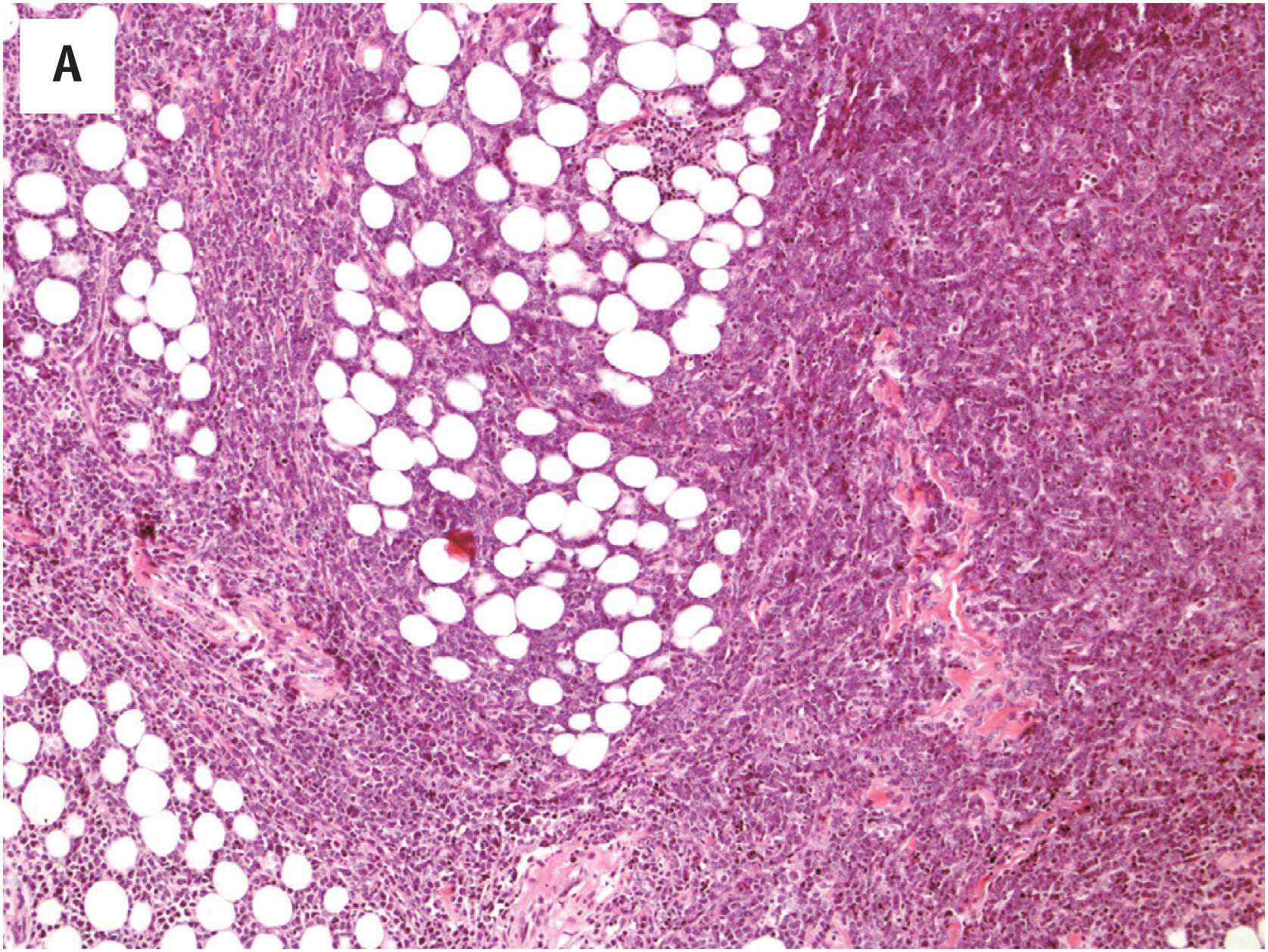
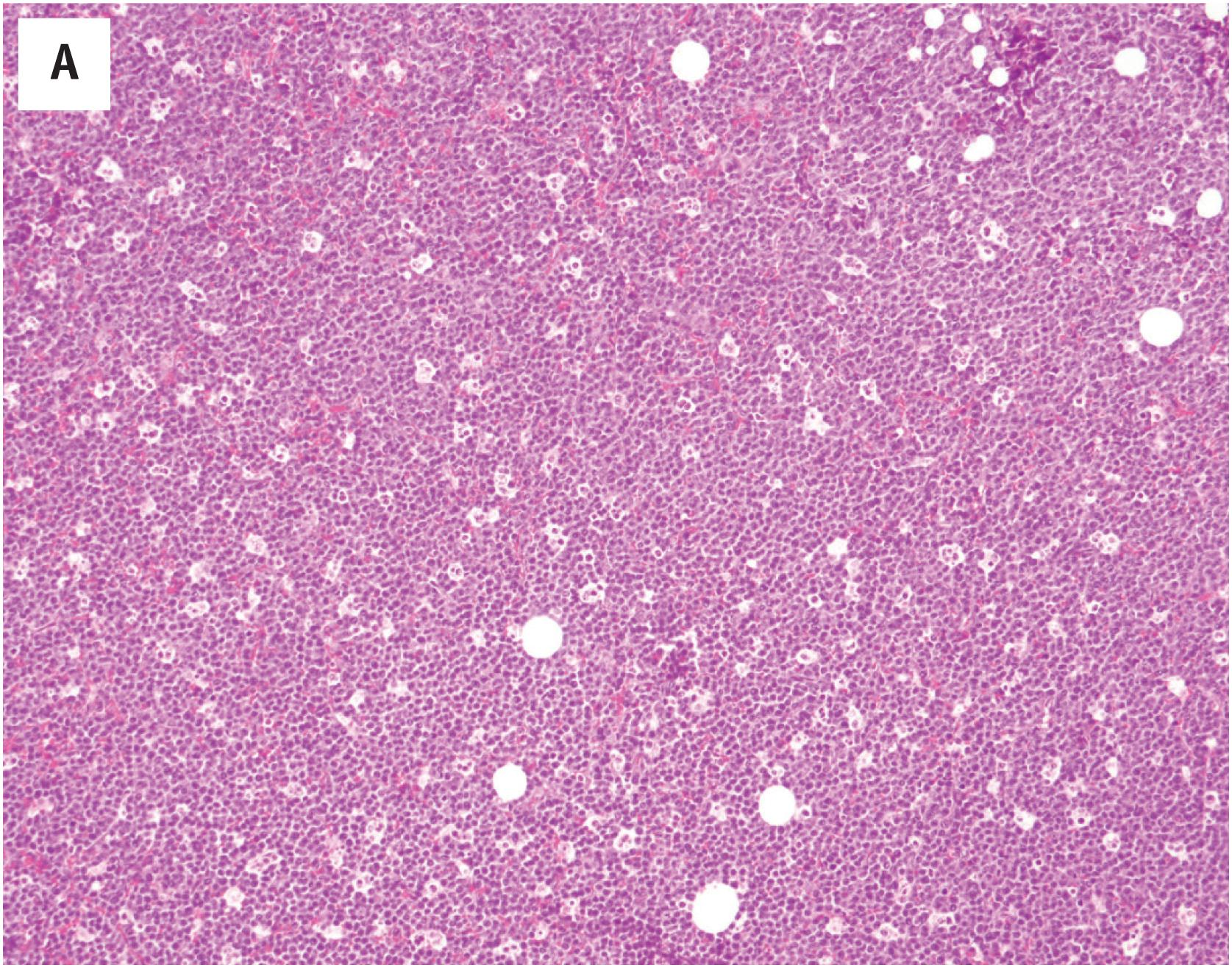
Become a Clinical Tree membership for Full access and enjoy Unlimited articles
If you are a member. Log in here